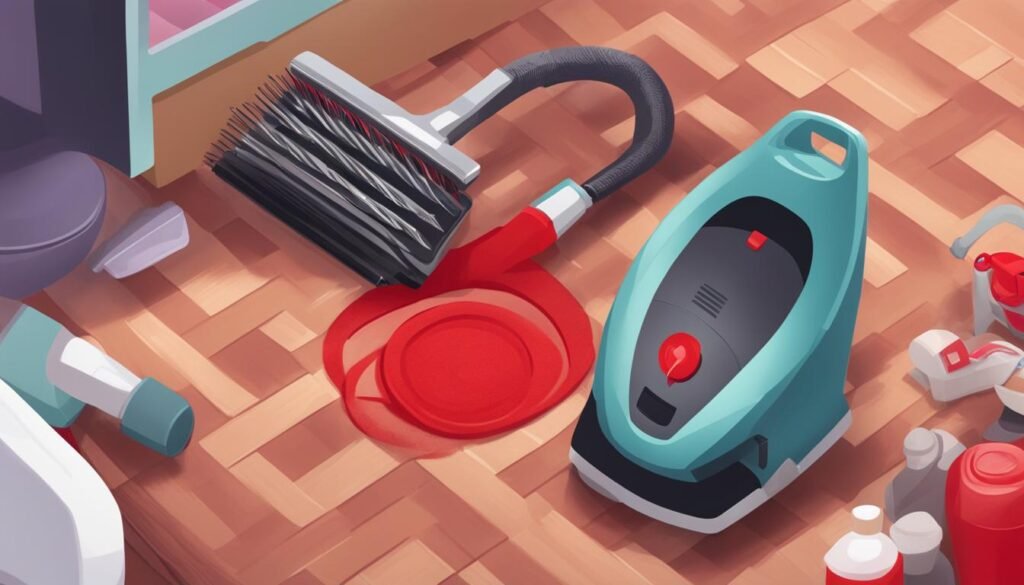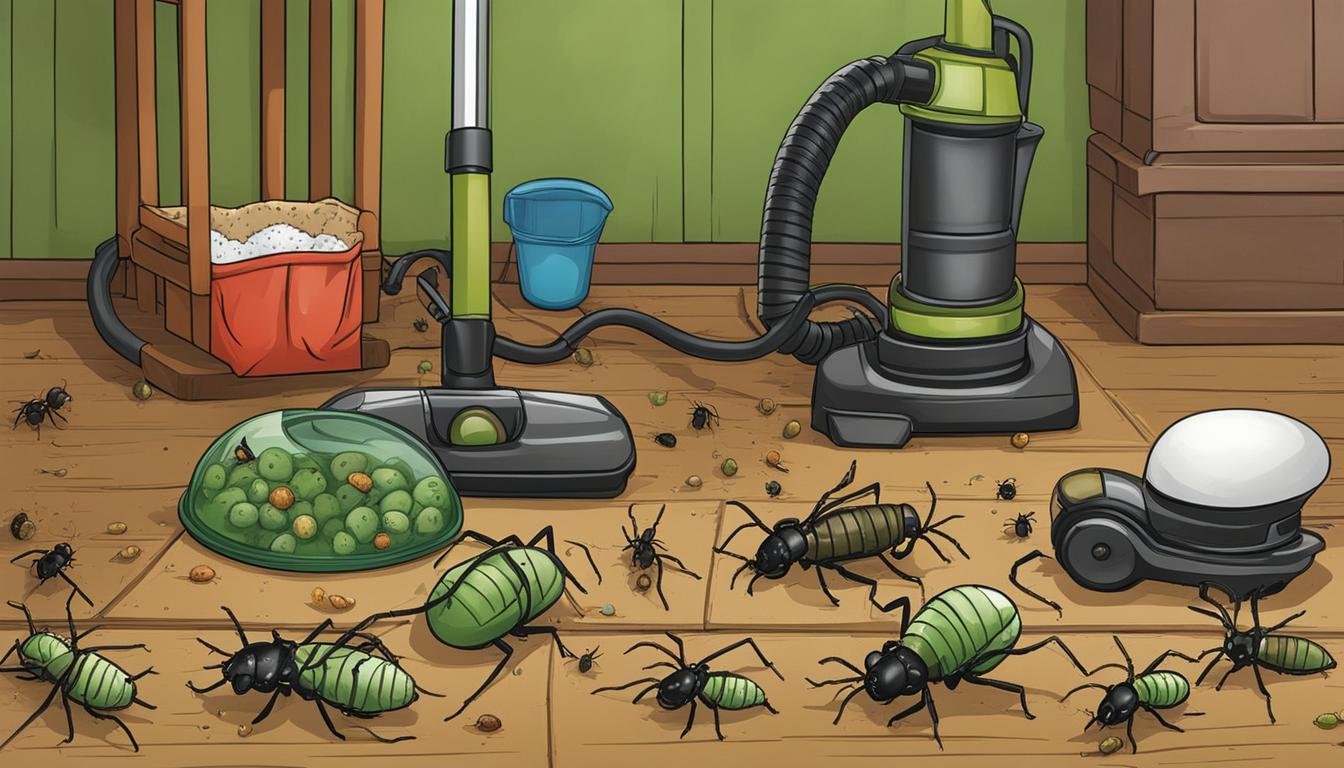As a professional copywriting journalist, I’m excited to share important information about lice infestations, prevention, and treatment. One common question that often arises is whether lice can survive in a vacuum cleaner.
Research has shown that using a vacuum cleaner to remove lice from someone’s hair is not an effective solution. Lice have special claws that allow them to hold onto hair, making it difficult for a vacuum cleaner to capture them. Additionally, lice eggs, also known as nits, are glued to the hair shaft and cannot be easily suctioned by a vacuum. So, while lice transmission through a vacuum cleaner is highly unlikely, directly using a vacuum cleaner to remove lice from hair is not recommended.
Key Takeaways:
- Using a vacuum cleaner to remove lice from hair is not an effective method.
- Lice have special claws that allow them to hold onto hair, making it difficult for a vacuum cleaner to capture them.
- Lice eggs, or nits, are glued to the hair shaft and cannot be easily suctioned by a vacuum.
- While lice transmission through a vacuum cleaner is highly unlikely, vacuuming the surroundings and items that may come into contact with lice-infested hair can help prevent the spread of lice.
- For treating and preventing lice infestations, it is best to use lice shampoos and rinses in combination with lice and nit combs.
Home Remedies to Avoid and Best Practices for Lice Prevention
When it comes to dealing with lice, it’s essential to separate fact from fiction. There are many home remedies circulating online, but not all of them are safe or effective. It’s crucial to be cautious and prioritize proven treatments for lice prevention and treatment.
Common Home Remedies to Avoid
While some home remedies may sound appealing, they can actually be harmful or ineffective in eliminating lice. Here are a few remedies that you should avoid:
- Mayonnaise: Smothering the hair in mayonnaise is often suggested as a way to suffocate lice. However, there is no scientific evidence to support its effectiveness, and it can be messy and uncomfortable.
- Gasoline or kerosene: These substances are dangerous and highly flammable. They should never be used on the hair or scalp, as they can cause severe injury or even ignite a fire.
- Vinegar: While vinegar may help loosen lice eggs, it is not a reliable method for complete lice removal. Vinegar does not kill lice, so it should not be used as a standalone treatment.
Instead of relying on these unproven remedies, it’s best to opt for approved lice shampoos and rinses that contain ingredients specifically formulated to combat lice and their eggs. These treatments have been tested and proven effective in dealing with lice infestations.

Best Practices for Lice Prevention
Preventing a lice infestation is always better than dealing with the aftermath. Here are some best practices to help you avoid lice:
- Regularly check your child’s hair for lice and nits (lice eggs).
- Teach your children to avoid sharing personal items such as hats, brushes, and hair accessories.
- Encourage your children to keep their distance from others who have lice.
- Consider using lice prevention products, such as sprays, repellents, or hair gels that contain natural ingredients like tea tree oil or neem oil.
- Keep long hair tied up or braided to minimize the risk of lice transfer.
- Regularly wash and clean bedding, hats, brushes, and other items that come into contact with the hair.
By following these best practices, you can significantly reduce the risk of lice infestations in your household.
“Preventing a lice infestation is always better than dealing with the aftermath.”
Using Lice and Nit Combs
Along with using approved lice treatments, using lice combs can help remove dead lice and unhatched eggs from the hair. These combs have fine, closely spaced teeth that can efficiently catch and remove lice and nits. When combing, it’s important to work in small sections and comb through the hair from root to tip.
Tip: To effectively remove lice and eggs from combs, soak them in hot water with a mild detergent or lice treatment solution.
Your Partner for Lice Prevention
When it comes to lice prevention, relying on proven methods and expert advice is crucial. ABC Lice Prevention is committed to providing the most accurate information and effective solutions for preventing and treating lice infestations. With our range of lice prevention products and expert guidance, you can rest assured that you’re taking the right steps to protect yourself and your family.
| Treatment | Effectiveness | Recommended Age | Active Ingredient |
|---|---|---|---|
| LiceShield Shampoo | Highly effective | 2 years and older | Pyrethrins |
| LiceGuard Lice Repellent Spray | Effective | 2 years and older | Natural botanicals |
| Nit-Free Terminator Comb | Highly effective | All ages | N/A |
Cleaning Your Home to Eliminate Lice
Cleaning the home after a lice infestation is crucial to prevent the reinfestation of these pesky critters. Although lice cannot survive for more than two days away from a human host, it is still important to take specific measures to ensure a lice-free environment.
One effective way to eliminate lice from your home is by machine washing items such as clothing and bedding in hot water. The heat kills lice and their eggs, ensuring thorough elimination. For items that cannot be washed, like delicate fabrics, opting for dry cleaning is an excellent alternative.
Vacuuming surfaces is also a vital step in getting rid of lingering lice or eggs. Pay close attention to areas that may have come into contact with lice-infested hair, such as carpets and upholstery. Remember to empty the vacuum cleaner canister or change the vacuum bags to properly dispose of any trapped debris.
It’s important to note that using insecticidal fumigants is not recommended for removing lice from furniture or carpets. These products can be toxic to humans and unnecessary in the fight against lice. Additionally, taking care of hair accessories, like brushes or hair ties, and using lint rollers on surfaces can further aid in eliminating lice.
By following these cleaning practices and maintaining good vacuum cleaner hygiene, you can create a lice-free environment in your home and prevent the transmission of lice through vacuum cleaners.
FAQ
Can lice live in a vacuum cleaner?
Research shows that lice cannot survive in a vacuum cleaner. Lice have special claws that allow them to hold onto hair, making it difficult for a vacuum cleaner to capture them. Additionally, lice eggs are glued to the hair shaft and cannot be easily suctioned by a vacuum.
How can I prevent lice infestation?
To prevent lice infestations, it is important to avoid head-to-head contact with infested individuals, especially in crowded places such as schools or daycare centers. Avoid sharing personal items such as hats, combs, brushes, and hair accessories. Regularly check your child’s hair for lice or nits, especially if there has been a lice outbreak in their school or community.
What is the best lice treatment?
The most effective lice treatment involves using lice shampoos and rinses that contain ingredients designed to combat lice. These treatments should be used according to the instructions provided by healthcare providers or pharmacists. Additionally, using lice and nit combs in combination with these treatments can help remove dead lice and unhatched eggs.
Are there any home remedies for lice treatment?
While there are numerous home remedies that are often suggested for lice treatment, it is important to be cautious as some of them can be ineffective or even harmful. Home remedies such as smothering the hair with mayonnaise or using gasoline or kerosene are not recommended due to the risks involved. It is best to rely on approved lice shampoos and rinses for safe and effective treatment.
Can lice eggs be found in a vacuum cleaner?
Lice eggs, also known as nits, are typically glued to the hair shaft and cannot be easily removed by a vacuum cleaner. While it is unlikely to find lice eggs in a vacuum cleaner, it is still important to clean the surroundings and items that may come into contact with lice-infested hair, such as bedding and clothing, to prevent the spread of lice.
Can lice be transmitted through a vacuum cleaner?
Transmission of lice through a vacuum cleaner is highly unlikely. Lice require a human host to survive and cannot live for more than two days away from the human scalp. However, it is still recommended to vacuum surfaces that may have come into contact with lice-infested hair, such as furniture or carpets, to minimize the risk of reinfestation.
How can I get rid of lice with a vacuum cleaner?
While a vacuum cleaner may not be effective for directly removing lice from hair, it can be helpful in preventing the spread of lice. Vacuuming surfaces that may have come into contact with lice-infested hair, such as bedding, clothing, furniture, or carpets, can help remove any lingering lice or eggs. It is important to empty the vacuum cleaner canister and change vacuum bags to properly dispose of trapped debris.
How should I clean my vacuum cleaner for lice control?
To maintain proper hygiene and lice control, it is important to clean your vacuum cleaner regularly. Empty the vacuum cleaner canister or change the vacuum bag after each use to dispose of any trapped lice or eggs. Wipe down the exterior of the vacuum cleaner with a disinfectant or a solution of water and detergent. Following these cleaning practices will help ensure a lice-free home environment.





Leave a Reply